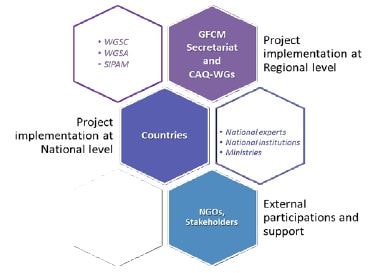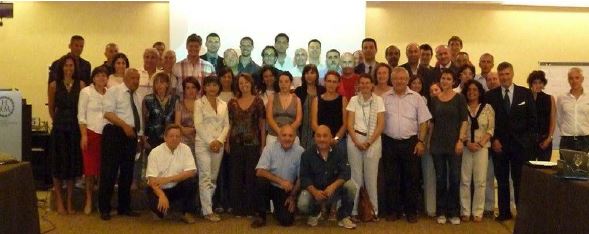1.2. The LaMed-2 project
1.2.1 Objectives
In light of the clear gaps and needs in coastal lagoon regional management highlighted within the framework of FAO and GFCM over the years, the GFCM Secretariat drafted and submitted, in 2010, a project proposal on lagoons to be presented to the Directorate General for Fisheries and Aquaculture of the MiPAAF, which expressed particular interest is this topic and decided to fund the initiative within the component 2 of the LaMed Project (hereafter “LaMed-2”).
The main objective of LaMed-2 was to:
Explore the main issues in dealing with interactions between aquaculture and capture fisheries in Mediterranean coastal lagoons in its sustainability dimensions (environmental, economic, social and governance).
To fulfill this aim, an inventory of Mediterranean coastal lagoons was compiled to gather existing information on sites, their environmental features as well as human activities carried out within lagoons and in surrounding areas, with particular reference to aquaculture and capture fisheries. The scientific and technical outputs of the project were intended to be integrated into the GFCM decision-making process through the CAQ. The GFCM countries, as the main beneficiaries of the project, would thus have been provided with suitable background information for a better management of their coastal lagoons.
1.2.2 Project strategy and implementation
With the aim of exploring the main issues related to the interactions between aquaculture and capture fisheries in Mediterranean coastal lagoons, the LaMed-2 strategy consisted in assisting GFCM countries2 in the process of analyzing the status of aquaculture and capture fisheries activities in coastal lagoons within ICZM and from an integrated ecosystem perspective.
The project was implemented at the Mediterranean level under the overall responsibility of the GFCM Secretariat. For activities to be carried out at the national level, cooperation was established between GFCM and the competent administrative and research institutions/departments for aquaculture development and the main responsibilities for project implementation were addressed (Fig. 1).
2 Albania, Algeria, Bulgaria, Croatia, Cyprus, Egypt, France, Greece, Israel, Italy, Japan, Lebanon, Libya, Malta, Monaco, Montenegro, Morocco, Romania, Slovenia, Spain, Syrian Arab Republic, Tunisia, Turkey and the EU.
3
The participation in project activities or the provision of assistance from other ministries in charge of coastal lagoon management was coordinated in cooperation with the national GFCM/CAQ focal points. The project strategy also contemplated the participation of officers, local experts, research institutions and, whenever possible, local stakeholders and non
governmental organizations (NGOs) in the different activities. The project development also took advantage from activities carried out by the CAQ subsidiary bodies, with which strong links were established. An extensive recourse was made to the human resources and expertise available in CAQ working groups, namely the Working Group on Site Selection and Carrying Capacity (WGSC), the Working
Group on Sustainability in Aquaculture (WGSA) and the Information System for the Promotion of Aquaculture in the Mediterranean (SIPAM). This optimized use of resources ensured a high level of countries participation in the implementation and follow-up of the project.

Figure 1. LaMed-2 strategy plan and cooperation mechanisms
The project started with the establishment of a network of experts in Mediterranean coastal lagoons – the LaMed-2 Expert Network – who worked together to carry out the project activities, starting from an inventory of lagoons in Mediterranean countries. Designated national
4
experts prepared: i) Profiles for each coastal lagoon (or system of coastal lagoons in a specific geographic area) in their country, providing generalities and relevant information and ii) Fact sheets on selected lagoons providing typical examples of different lagoon typologies existing in their country (e.g. differences in ecology, management, ownership) or representing the major lagoons systems. Finally, the information gathered through profiles and fact sheets was collated into a final country report3 placing particular emphasis on interactions among aquaculture, capture fisheries and the environment. During this process, the expert network convened a meeting on “Mediterranean coastal lagoons management: interactions between aquaculture and capture fisheries” (Cagliari, Italy, 28–30 June 2011) to further discuss major issues related to lagoon environment (Fig. 2). Progress was made towards the analysis and understanding of interactions among aquaculture, capture fisheries and the environment by integrating several studies and data on fisheries in coastal lagoons. The following paragraph outlines the main topics discussed and the main outcomes of the meeting.

Figure 2. LaMed-2 activities and expert network
3 Country reports from Albania, Algeria, Egypt, France, Greece, Italy, Montenegro, Morocco, Spain, Tunisia and Turkey are included in PART 2 of the present publication.
The CAQ meeting on “Mediterranean coastal lagoons management: interactions between aquaculture and capture fisheries” (LaMed-2). A step towards a GFCM management plan on coastal lagoons
On the occasion of the meeting on “Mediterranean coastal lagoons management: interactions between aquaculture and capture fisheries”, the LaMed-2 expert network had a chance to present and review the status of coastal lagoons in each country (GFCM, 20114) and to discuss the importance of preserving fisheries activities sensu lato in lagoon systems, also in light of their significant contribution to the regional/global fish supply.

Participants of the CAQ meeting on “Mediterranean coastal lagoons management: interactions between aquaculture and capture fisheries” (La Med-2) (Cagliari, Italy, June 2011)
The process of reviewing the status of coastal lagoons in the Mediterranean basin clearly highlighted that an environmental degradation had occurred over time in many lagoons and 5
had entailed negative impacts on fish resources, which subsequently led to a consistent decrease of aquaculture/capture fisheries production.
In fact, although demanding different types of management and representing different forms of exploitation, extensive aquaculture and artisanal capture fisheries are strongly linked due to the common use of living resources within the lagoon ecosystems. The sustainability of both largely depends on the stability of the lagoons’ ecological conditions and on the state of target fish populations. In this view, it was recognized that the fundamental role of “traditional” fishers’
knowledge on lagoons had been contributing, since ancient times, to maintain favourable conditions to preserve the ephemeral lagoon environment.
The experts agreed that the existing detrimental conditions, which characterized the majority of Mediterranean lagoons, were determined by a lack or insufficiency of lagoon management plans and unclear legal regulatory frameworks. These inadequacies had led to environmental and socioeconomic issues, including negative effects on lagoons’ fishing communities, and could cause the loss of their traditional knowledge and biodiversity.
Lagoon management is therefore recognized as the main instrument to keep preserving the ecological features of lagoons and prevent the degradation of their sensitive habitats, both from an environmental and socioeconomic point of view. In particular, experts underlined that, in order to guarantee the sustainability of aquaculture and capture fisheries in lagoons, an adequate management plan should be in place.
In light of the above aims, any coastal lagoon management plan in the GFCM area should: 1. Be in line with the CCRF and in particular with the provisions referring to aquatic ecosystems, fish habitats, multiple uses of coastal zones, ICZM, the participation of
4 http://151.1.154.86/GfcmWebSite/CAQ/LaMed-2/2011/Report_LaMed2_Cagliari2011.pdf
5
fishers, environmental and other interested organizations, the role of artisanal fisheries and aquaculture including culture-based fisheries, in accordance with international laws; 2. Factor in the principles of the main international conventions and declarations regarding the protection and conservation of coastal lagoon areas and, more generally, of sensitive habitats and biodiversity, giving emphasis to the role played by local communities in coastal areas;
3. Consider traditional aquaculture and artisanal capture fisheries as a management priority, since they contribute in particular to the conservation of the ecological and economic services provided by the ecosystem and of lagoon biodiversity. In particular, the preservation of fishers’ traditional knowledge should be considered as an element of common interest for Mediterranean countries to be shared and capitalized.
The experts recognized that, in order to efficiently reflect these principles into sustainable management plans for aquaculture and capture fisheries in Mediterranean coastal lagoons, there was a need to foster the development of a common regional strategy and to implement it in a cooperative approach. It was recognized that this common regional strategy should focus on preventing coastal lagoons from any further degradation and take into account solutions to restore the environment.
In this view, the meeting concluded that a Mediterranean management plan for coastal lagoons could be potentially developed to identify suitable management strategies based on a multifunctional, disciplinary and stakeholder approach, with the aims of: i) preserving wetlands and nursery areas for selected biological communities; ii) protecting traditional management practices such as artisanal capture fisheries and extensive aquaculture; and iii) avoiding any intensification of such activities.
A management plan for lagoons could be considered as an important tool for the protection of fisheries and aquaculture activities and an active component in conservation policies taking into account integrated coastal management and the ecosystem approach.
1.2.3 Project outputs
In conclusion, the activities implemented within the LaMed-2 project allowed scientists to review the state of Mediterranean coastal lagoons and to identify the main issues related to environment and to the human activities carried out in these areas. The lack of adequate management of lagoons and related fisheries activities was identified as a limiting factor reducing the capacity to control ecological and socioeconomic damages caused to lagoons. This review enabled to draw an up-to-date picture of the state of coastal lagoons in the region and to identify key concepts to be included in sustainable management plans for lagoons towards their environmental protection and the conservation of their human, cultural and traditional heritage.
The information gathered through the project also contributed to build and update the background information. This process facilitated the development of guidelines and recommendations on the interactions between capture fisheries and aquaculture through a systemic approach taking into account ecological, economic, governance and legal factors. Given the peculiar nature of these ecosystems, where aquaculture, capture fisheries and the environment interact together, various elements have been identified to elaborate a regional management plan, starting from a set of guidelines for the sustainable management of lagoons. It emerged from the CAQ LaMed-2 expert meeting that discussing and developing proposals for a future management plan and guidelines for coastal lagoons had to be considered as a priority in the agenda of Mediterranean countries, and that the GFCM – thanks to its capacity to involve all countries and possible stakeholders at the regional level – was the most appropriate forum to pursue the process initiated within LaMed-2.